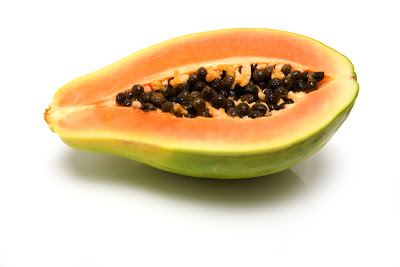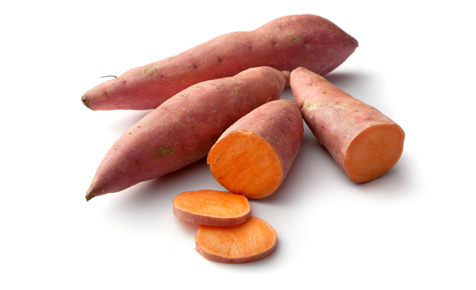Most of us usually don’t eat these 6 ‘things’ and throw them into the rubbish bin, but these 6 foods can be really healthy and nutritious.
Papaya Seeds
 Perhaps you’ve already heard of the wonderful benefits that papaya can offer your body and health, whether it is from eating the natural, healthy fruit or from using the many lotions, soaps, and washes that are papaya-based and nourish your skin. However, there is a part of this amazing fruit that many people may not realize is just as healthy and beneficial – the papaya seeds.
Perhaps you’ve already heard of the wonderful benefits that papaya can offer your body and health, whether it is from eating the natural, healthy fruit or from using the many lotions, soaps, and washes that are papaya-based and nourish your skin. However, there is a part of this amazing fruit that many people may not realize is just as healthy and beneficial – the papaya seeds.
Though eating papaya seeds may not seem as appealing as eating the rest of the fruit, and though the seeds may have a stronger, crunchier taste to them, they are still very edible and very much worth the effort of eating. One of the main benefits that papaya provides is its anti-bacterial quality.
This means that eating papaya seeds can help reduce the occurrence of bacterial infections, as well as decrease the chance of inflammation, and the conditions and sicknesses that are caused by it, from developing in your body.
Papaya seeds also help detoxify your body from parasites and similar infections due to their high enzyme content which make your digestive tract a hostile place for parasites, worms, and infections. Papaya seeds can also act as a deterrent to liver cirrhosis, which is a disease that causes your liver to shrink and harden, rendering it ineffective in its task of filtering toxins out of your body.
It should be important to note, however, that papaya seeds should not be eaten by pregnant women and should be taken in regular intervals with distinct breaks, instead of prolonged, continuous consumption.
Pumpkin Skin
Most of the time, pumpkins are eaten in the form of soup, pie, or many other types of savory presentations, but rarely is the pumpkin skin thought about. In fact, the only time you might pay attention to a pumpkin’s skin is when it’s being used as a Jack-O-Lantern for Halloween. The skin of the pumpkin, however, actually contains a wide and rich variety of perks that will have you paying attention to it all year round.
The list of benefits that pumpkin skin can provide will surprise and astonish you. One of its foremost benefits is that pumpkin skin, due to its rich vitamin and nutrient nature, is very good and healthy for your skin. It can nourish your skin by washing away dead skin cells and encouraging the growth of new ones, reducing the prominence of any lines or wrinkles on your face, and making your skin feel smooth and appear youthful. One other reason for pumpkin skin to be popular is that it can be applied on almost any skin type. As it contains high amounts of vitamins E and T, pumpkin skin is quite useful in preventing breakouts of acne and pimples.
Pumpkin skin can be consumed in many ways. The simplest would be to simply include them with the rest of the pumpkin flesh in whatever dish you are concocting. Alternatively, you can grate the skin into pumpkin soup to enhance the flavor, or cut the pumpkin pieces into wedges and roast them. You can even make delicious pumpkin skin chips. Just make sure to get fresh and young pumpkins to avoid the old, dry, and tough skins of the more aged pumpkins. In addition, be sure to only eat organically grown pumpkins, to avoid any harmful and unnatural chemicals that may have been left over from pesticide usage.
Sweet Potato Skin
 Between the much more famous regular potato (which, among other things, is used to create the rather unhealthy fast food favorite French Fries) and the Thanksgiving “yam,” the sweet potato is often ignored, misunderstood, and sometimes outright unheard of. The truth of the matter is, the sweet potato and its skin hold so many benefits and perks for your health that it might be the only type of potato you would want to eat.
Between the much more famous regular potato (which, among other things, is used to create the rather unhealthy fast food favorite French Fries) and the Thanksgiving “yam,” the sweet potato is often ignored, misunderstood, and sometimes outright unheard of. The truth of the matter is, the sweet potato and its skin hold so many benefits and perks for your health that it might be the only type of potato you would want to eat.
Though many people refer to the Thanksgiving treat as “yams,” most “yams” are actually just a variety of sweet potatoes that have been misnamed or mislabeled, and real yams are actually considerably different from the Thanksgiving staple. Sweet potatoes are rich in numerous vitamins and minerals such as magnesium, potassium, iron, vitamin D, vitamin C, and vitamin B6. Sweet potato skins are especially beneficial because the skin is where most of the nutrients, as well as fiber, are concentrated. These components, among other benefits, help produce collagen which retains the skin’s youthfulness, prevent heart attacks, strengthen your bones, and increase the production of white blood cells which are an important part of your immune system. Sweet potato skins can also help regulate the flow of sugar in your body, as well as regulate your metabolism and heart rate.
Sweet potato should not merely be reserved for Thanksgiving anymore as you can enjoy it in numerous ways aside from its standard “yam” form. Almost any form of cooking, from boiling to roasting, from grilling to steaming, to being made part of a soup can be applied to the sweet potato and its skin to create a wonderfully appetizing and healthy dish. Again, eat only organically grown produce, especially when it comes to the skin, to avoid consuming chemicals possibly used in pesticides.
Citrus Peels
Whether you eat oranges, lemons, limes or any other kind of citrus fruit, it often goes that after you’ve eaten or juiced your citrus-based fruit, you often simply throw away the peels. However, once you realize how healthy and valuable these oft overlooked peels are, you might just start eating oranges and lemons just to get their peels!
Obviously, one of the things that citrus peels can offer you is a high vitamin C content, which helps your skin retain its youthful texture and healthy complexion, strengthens your immune system against possible deficiencies, acts as an antioxidant which protects your body against free radicals and flushes them out of your system, and even helps improve your eyesight. Other lesser known benefits of citrus peels include helping regulate your cholesterol, which help lower heart and other cardiovascular diseases as well as reducing the risk of developing diabetes, and even acting as a deterrent against cancer.
There is an extremely wide variety of ways of enjoying and incorporating citrus peels into your foods. The most well-known might be grating a bit of a lemon on some salad or marinade to give your dish that little kick, but you can also infuse them into your tea or coffee, make candied peels, or use them as seasoning for your meatier main dishes. Just remember to give them a good and thorough cleansing before using them. Also, it now goes without saying that one should avoid the chemicals and pesticides on the peels by eating only naturally and organically grown citrus.
Kiwi Skin
Though the skin of the kiwi fruit may not look like the most appealing or appetizing thing to eat, if you look past the odd, unusual exterior of this fruit, you will find yourself with something that provides your body with an astonishing and exceptional amount of health perks and benefits.
Eating the kiwi fruit raw, with the skin included, is actually a common practice among the “Kiwis” of New Zealand (from which the fruit takes its namesake). Knowing this may perhaps lessen any hesitations or apprehensions one might have from eating its skin. The skin of the kiwifruit is jam packed with a load of antioxidants which flush your body of free radicals and help strengthen and protect your heart from disease. It can also greatly improve your metabolism and help your immune system fortify itself. The high enzyme content of the kiwi fruit’s skin is also very helpful towards improving digestion, filtering toxins from your body, keeping your blood healthy, and regulating your body’s cholesterol. The skin can also help with those who suffer from constipation by improving the transit time of bowel movement.
The fuzziness of the kiwi fruit’s skin may be too much for some people to handle, which is why you can “shave” the fuzz off while still leaving most of the skin intact for consumption and retaining its benefits. Just be sure to clean the skin properly, as the fuzz of the fruit is prone to “catch” more dirt and debris. Once again, only eat the skins of organically grown, pesticide-free kiwis.
Watermelon Seeds
 When you eat watermelon, most of the time the watermelons seeds are just little more than an annoying nuisance that causes you to pause from your enjoyment of the sweet, refreshing fruit, in order to spit them out. However, these tiny, numerous seeds actually contain almost as much nutritional content and health benefits as the great, big watermelons that they eventually create do.
When you eat watermelon, most of the time the watermelons seeds are just little more than an annoying nuisance that causes you to pause from your enjoyment of the sweet, refreshing fruit, in order to spit them out. However, these tiny, numerous seeds actually contain almost as much nutritional content and health benefits as the great, big watermelons that they eventually create do.
Watermelon seeds are actually very high in protein, with one cup of dried watermelon seeds providing almost up to 60 percent of the recommended daily protein intake. This is essential in the regulation of blood pressure and the prevention of heart and many other cardiovascular diseases.
The tiny watermelon seeds are also rich in mineral content. These minerals include iron, potassium, zinc, sodium, copper, and magnesium, with the last being one of the most abundant. These minerals help maintain and improve not only blood sugar levels in your body, but your metabolism as well. The healthy fats found in watermelon seeds help regulate blood sugar and blood pressure levels as well. Vitamin B is also very abundant in watermelon seeds and helps your body feel and look young and healthy, with the vitamins assisting in providing energy for your body while keeping your skin youthful and fresh.
There are a number of ways to enjoy watermelon seeds, from eating them roasted to incorporating them in your soups.
Now that you know the wonders of these often disregarded and discarded health storehouses, one thing for sure is that you will never think little of these seeds and skins, ever again.
About the Author:
Emma Deangela is the best selling author of The Alkaline Diet Program and 80/20 Fat Loss. She has helped over tens of thousands of men and women to lose weight and transform their health with sound nutrition advice.
Which wonderful friends in your life would appreciate this information about these 6 surprising health food? Are they already eating these 6 foods??
Please help them by sharing this eye-opening article with each of them using any of the social media and email buttons below.
Leave a Reply